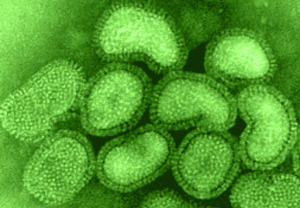Comments gathered by the Science Media Centre based in London.
New Zealand and Australian expert comment can be found here.
Dr Anne Bridgen, Department of Biomedical Sciences, University of Ulster, said:
 “These porcine H1N1 viruses are quite antigenically distinct from the human H1N1 so there is not likely to be much protection from human H1N1 vaccines, and even less from more distantly related viruses. Pity, I was hoping they would offer some protection too as human H1N1 is part of the current influenza A virus vaccine.”
“These porcine H1N1 viruses are quite antigenically distinct from the human H1N1 so there is not likely to be much protection from human H1N1 vaccines, and even less from more distantly related viruses. Pity, I was hoping they would offer some protection too as human H1N1 is part of the current influenza A virus vaccine.”
Prof Ian Jones, Professor of Virology, School of Biological Sciences, University of Reading, said:
“The current vaccine is made up of three Influenza strains to reflect currently circulating human influenza; that is a H1 virus, a H3 virus and type B virus. The recommended vaccines for use in the 2009-2010 influenza season (northern hemisphere winter) from WHO are made up of an A/Brisbane/59/2007 (H1N1)-like virus; A/Brisbane/10/2007 (H3N2)-like virus; and B/Brisbane/60/2008-like virus.
“The response to the vaccine in vaccines is made up of two components, antibodies and T cells. Antibodies provide protection while T cells generally shorten the period of infection.
“Although the current swine flu is a H1 it is only 85% related to A/Brisbane/59/2007. This relatedness is lower than many yearly changes in flu vaccines so it is doubtful that the current advised vaccine strain would be effective against it in the production of antibodies. The T cell response is, however, likely to be cross reactive. The most likely result is that a current vaccination would not stop you from being infected but might reduce the severity of the symptoms.”
Prof Nigel Dimmock, Emeritus Professor of Virology, University of Warwick, said:
“What was swine flu is now human flu. The next 1-2 weeks will tell us whether or not this flu has the capacity of pandemic spread. However, even if it doesn’t, the virus still has the option of improving its fitness to spread by mutating – Darwin was right!”
Prof Paul Hunter, Professor of Health Protection, School of Medicine, Health Policy and Practice, University of East Anglia said:
“Swine influenza virus H1N1 is not the same as the human influenza virus H1N1 and is actually quite distinct. The clinical illness is however generally similar.
“One of the problems with swine flu is that the vaccine has a reputation of causing serious side effects. In 1976 an outbreak of swine flu in the US led to about 1/4 the population being vaccinated. An estimated 500 cases of Guillain-Barré syndrome with 25 deaths followed that were attributed to the vaccine. There were more deaths from the vaccine than from the outbreak. This is why people are talking about the use of antivirals rather than vaccine to control the outbreak.
“Although it is always very difficult to predict the course of an outbreak this early on, the fact that cases are already being reported from around the world is of concern. This suggests to me that the virus certainly does have epidemic potential. Without a widely available effective and safe vaccine, it would be difficult to do much to control the spread, though those countries like the UK with large stockpiles of antivirals will be able to reduce the severity of any impact and also reduce further spread of the infection.
“The important thing is that people with a flu-like illness, especially after returning from an area where cases have been reported, avoid contact with other people, phone their doctors rather than turn up.”
Further advice is contained in the HPA web site
Or the US CDC site
Dr. Steven McOrist, of UK Pig Veterinary Society, said:
“British veterinary groups have a responsibility, besides surveillance of our pig’s health and reassurance on food quality, to ensure that our main efforts are to work to prevent the introduction of this virus into the UK pig population. We therefore fully support all public health warnings and advice to contain the spread of the new human flu virus.
“While the new strain of human flu virus does contain some elements of swine flu strains, it has never been isolated from any pig in Mexico or the USA. There are no current reports of any significant swine flu issues in Mexican or US pigs. The actual “re-assortment vessel” where the new human strain developed is therefore not yet clear, it may have been in pigs or in wild fowl, poultry or humans.”
Dr Noemi Eiser, Honary Medical Director at the British Lung Foundation, said:
“People who have recently been to Mexico and are displaying any flu like symptoms such as a fever and aches and pains should seek medical advice immediately. This also applies to anyone who has been in close contact with people who have been in Mexico.
“There is no need to panic about swine flu. However, everyone should continue to take sensible precautions to help avoid the spread of all air-borne respiratory infections. This includes washing your hands and coughing and sneezing into tissues and disposing of them immediately.”